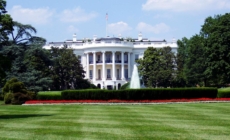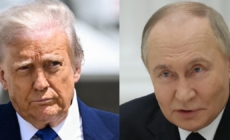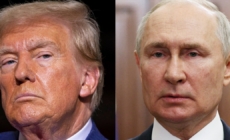-
Thousands of Afghans were resettled in Britain after a data leak put them in danger - 8 mins ago
-
Government Urges EU to Strike Tariff Deal with U.S. within Two Weeks - 21 mins ago
-
2025 MLB All-Star Game: What Was Happening The Last Time The Braves Hosted? - 27 mins ago
-
Millennial Mom Panics Kids Will Turn Out Like Her—Then She Sees Teenage Son - 37 mins ago
-
Trump threatens countries that do business with Russia with 100% tariffs. Here’s who it could impact. - 39 mins ago
-
Suki Waterhouse reveals tight pants caused hernia requiring hospitalization - 45 mins ago
-
Best Beaches on Lake Balaton Revealed - 54 mins ago
-
Europeans are still wary of Trump’s promises to Ukraine despite apparent U-turn on Putin - 57 mins ago
-
Every LIV golfer that has qualified for the 2025 Open Championship - about 1 hour ago
-
Commanders’ Jayden Daniels Lands High Spot in QB Rankings - about 1 hour ago
China’s second-quarter growth beats forecasts but deflation fears fuel calls for stimulus, deeper reform
China’s economy grew at a faster-than-expected rate in the second quarter, keeping the country on track to meet its full-year target of 5% and easing some pressure on policymakers to step up stimulus to underpin growth.
China’s gross domestic product expanded by 5.2% in the second quarter, according to China’s National Bureau of Statistics on Tuesday. While the growth rate beat Reuters-polled economists’ estimates of a 5.1% growth, it represented a slowdown from the 5.4% in the first quarter.
In June, retail sales growth slowed to 4.8% from a year earlier, compared with the 6.4% year-on-year increase in May. That figure also disappointed Reuters-polled economists’ forecast of 5.4%.
Catering sales, including food and beverages, edged up by just 0.9%, its worst performance since December 2022 when the country grappled with a receding pandemic, according to Wind Information.
Industrial output expanded by 6.8% from a year earlier, versus median estimates of 5.7%.
Fixed asset investment grew 2.8% in the first half of this year against estimates of a 3.6% increase in a Reuters poll. The slump in real estate investment deepened, falling 11.2% in the first half of the year, compared to a 10.7% drop in the first five months, while investment in infrastructure and manufacturing also slowed.
“The real estate market is still in a process of bottoming,” Laiyun Sheng, deputy commissioner at the NBS, said at a press briefing following the data release, calling for “stronger support” to stabilize the sector.
Domestic consumption contributed to 52% of GDP in the first half of the year, Sheng said, highlighting that the share of consumption rose in the second quarter while the contribution of trade fell. He spoke broadly of plans to support retail sales, and acknowledged that policymakers need to boost income to sustain a rebound in spending.
Sheng expected modest improvement in consumer prices in the second half of the year, citing Beijing’s efforts to encourage spending while stopping disorderly price wars.
The urban unemployment rate remained at 5% in June, after touching a two-year high of 5.4% in February.
“Although growth is likely to slow in the second half-year, the 5% government target may be within reach,” said Tianchen Xu, senior economist at Economist Intelligence Unit, who expected policymakers to refrain from rolling out additional stimulus measures at an upcoming meeting of the Communist Party’s Politburo in late July.
Beijing could hold off major stimulus until September to stage a final push to meet its growth target if momentum falters, Xu added.
Tariff wildcard
In April, U.S. President Donald Trump ratchet up tariffs on Chinese imports to a prohibitive level of 145%, spurring a round of stimulus measures from Beijing, including financial support for exporters struggling to take orders, subsidies for companies that hire fresh graduates and continuous expansion of a consumer goods trade-in program to boost demand.
The two sides reached a truce in May, agreeing to roll back most of their tariffs on one another. Their respective trade negotiators later outlined a framework after a meeting in London in June, which involved China expediting approval for exports of rare-earth minerals and Washington walking back its restrictions on Beijing’s access to advanced American technologies and Chinese students’ visas to study in the U.S.
Beijing faces an Aug. 12 deadline to work out a permanent deal with Washington.
U.S. Treasury Secretary Scott Bessent told CNBC earlier this month that he expected a meeting with his Chinese counterpart “in the next couple of weeks” to advance discussion on trade and other matters.
“If the threat of trade war diminishes at least in the short term, the chance of a large fiscal stimulus in China also declines,” said Zhiwei Zhang, president and chief economist at Pinpoint Asset Management.
Calls for stimulus
China’s economy has remained on a generally firm footing this year, buoyed by robust exports and support measures, but economists are largely cautious of more economic headwinds ahead, calling for the leadership to launch fresh fiscal stimulus.
“The above-target growth in Q1 and Q2 gives the government room to tolerate some slowdown in the second half of the year,” said Zhang.
The Chinese leadership in May unveiled a slew of policy steps in its bid to shore up the tariff-hit economy, including cutting interest rates and injecting additional liquidity into the market.
The stimulus measures have lifted parts of the economy. Both official and private surveys showed an improvement in the manufacturing activity.
Exports have also remained largely resilient in the quarter as businesses accelerated to divert trade to alternative markets. Its U.S.-bound shipment shrank 10.9% this year as of June, while exports to Southeast Asia nations and European Union countries — the groupings China counts as its two largest trading partners — jumped 13% and 6.6%, respectively.
However, that resilience was mainly driven by “price discounting,” which was “eroding” China’s terms of trade and intensifying disinflationary pressures, Louise Loo, head of Asia economics at Oxford Economics, said in a note.
China’s GDP deflator, a broad measure of prices across goods and services, however, was still down 1.2% year-on-year, marking the sharpest decline since the global financial crisis, Loo added.
PBOC advisor Huang Yiping, in a report published last week with two other economists, said that authorities need to add as much as 1.5 trillion yuan in fiscal stimulus to spur household spending and offset impacts from the U.S. tariffs, as well as cut interest rates further.
“Deeper indicators such as soft consumer price index, weak purchasing managers’ index readings, cautious credit dynamics and elevated migrant worker unemployment point to underlying fragility,” the economists said.
Structural reforms around China’s fiscal plans, pension system and the financial sector are needed to ensure a more balanced, sustainable growth, the economists said.
Source link































